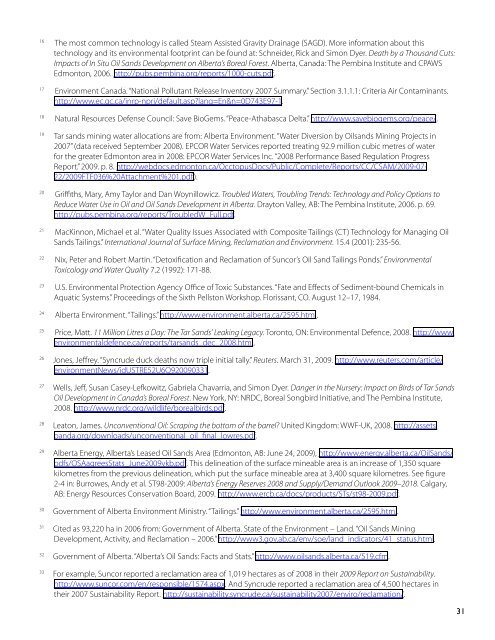l66nu8g
l66nu8g
l66nu8g
Create successful ePaper yourself
Turn your PDF publications into a flip-book with our unique Google optimized e-Paper software.
16<br />
The most common technology is called Steam Assisted Gravity Drainage (SAGD). More information about this<br />
technology and its environmental footprint can be found at: Schneider, Rick and Simon Dyer. Death by a Thousand Cuts:<br />
Impacts of In Situ Oil Sands Development on Alberta’s Boreal Forest. Alberta, Canada: The Pembina Institute and CPAWS<br />
Edmonton, 2006. http://pubs.pembina.org/reports/1000-cuts.pdf.<br />
17<br />
Environment Canada. “National Pollutant Release Inventory 2007 Summary.” Section 3.1.1.1: Criteria Air Contaminants.<br />
http://www.ec.gc.ca/inrp-npri/default.asp?lang=En&n=0D743E97-1.<br />
18<br />
Natural Resources Defense Council: Save BioGems. “Peace-Athabasca Delta.” http://www.savebiogems.org/peace/.<br />
19<br />
Tar sands mining water allocations are from: Alberta Environment. “Water Diversion by Oilsands Mining Projects in<br />
2007” (data received September 2008). EPCOR Water Services reported treating 92.9 million cubic metres of water<br />
for the greater Edmonton area in 2008: EPCOR Water Services Inc. “2008 Performance Based Regulation Progress<br />
Report.” 2009. p. 8. http://webdocs.edmonton.ca/OcctopusDocs/Public/Complete/Reports/CC/CSAM/2009-07-<br />
22/2009FTF036%20Attachment%201.pdf ).<br />
20<br />
Griffiths, Mary, Amy Taylor and Dan Woynillowicz. Troubled Waters, Troubling Trends: Technology and Policy Options to<br />
Reduce Water Use in Oil and Oil Sands Development in Alberta. Drayton Valley, AB: The Pembina Institute, 2006. p. 69.<br />
http://pubs.pembina.org/reports/TroubledW_Full.pdf.<br />
21<br />
MacKinnon, Michael et al. “Water Quality Issues Associated with Composite Tailings (CT) Technology for Managing Oil<br />
Sands Tailings.” International Journal of Surface Mining, Reclamation and Environment. 15.4 (2001): 235-56.<br />
22<br />
Nix, Peter and Robert Martin. “Detoxification and Reclamation of Suncor’s Oil Sand Tailings Ponds.” Environmental<br />
Toxicology and Water Quality 7.2 (1992): 171-88.<br />
23<br />
U.S. Environmental Protection Agency Office of Toxic Substances. “Fate and Effects of Sediment-bound Chemicals in<br />
Aquatic Systems.” Proceedings of the Sixth Pellston Workshop. Florissant, CO. August 12–17, 1984.<br />
24<br />
Alberta Environment. “Tailings.” http://www.environment.alberta.ca/2595.html.<br />
25<br />
Price, Matt. 11 Million Litres a Day: The Tar Sands’ Leaking Legacy. Toronto, ON: Environmental Defence, 2008. http://www.<br />
environmentaldefence.ca/reports/tarsands_dec_2008.html.<br />
26<br />
Jones, Jeffrey. “Syncrude duck deaths now triple initial tally.” Reuters. March 31, 2009. http://www.reuters.com/article/<br />
environmentNews/idUSTRE52U6Q920090331.<br />
27<br />
Wells, Jeff, Susan Casey-Lefkowitz, Gabriela Chavarria, and Simon Dyer. Danger in the Nursery: Impact on Birds of Tar Sands<br />
Oil Development in Canada’s Boreal Forest. New York, NY: NRDC, Boreal Songbird Initiative, and The Pembina Institute,<br />
2008. http://www.nrdc.org/wildlife/borealbirds.pdf.<br />
28<br />
Leaton, James. Unconventional Oil: Scraping the bottom of the barrel? United Kingdom: WWF-UK, 2008. http://assets.<br />
panda.org/downloads/unconventional_oil_final_lowres.pdf.<br />
29<br />
Alberta Energy, Alberta’s Leased Oil Sands Area (Edmonton, AB: June 24, 2009), http://www.energy.alberta.ca/OilSands/<br />
pdfs/OSAagreesStats_June2009vkb.pdf. This delineation of the surface mineable area is an increase of 1,350 square<br />
kilometres from the previous delineation, which put the surface mineable area at 3,400 square kilometres. See figure<br />
2-4 in: Burrowes, Andy et al. ST98-2009: Alberta’s Energy Reserves 2008 and Supply/Demand Outlook 2009–2018. Calgary,<br />
AB: Energy Resources Conservation Board, 2009. http://www.ercb.ca/docs/products/STs/st98-2009.pdf.<br />
30<br />
Government of Alberta Environment Ministry. “Tailings.” http://www.environment.alberta.ca/2595.html.<br />
31<br />
Cited as 93,220 ha in 2006 from: Government of Alberta. State of the Environment – Land. “Oil Sands Mining<br />
Development, Activity, and Reclamation – 2006.” http://www3.gov.ab.ca/env/soe/land_indicators/41_status.html.<br />
32<br />
Government of Alberta. “Alberta’s Oil Sands: Facts and Stats.” http://www.oilsands.alberta.ca/519.cfm.<br />
33<br />
For example, Suncor reported a reclamation area of 1,019 hectares as of 2008 in their 2009 Report on Sustainability.<br />
http://www.suncor.com/en/responsible/1574.aspx. And Syncrude reported a reclamation area of 4,500 hectares in<br />
their 2007 Sustainability Report. http://sustainability.syncrude.ca/sustainability2007/enviro/reclamation/.<br />
31


